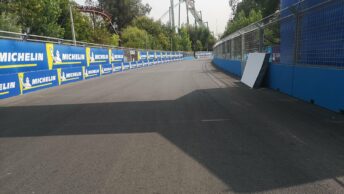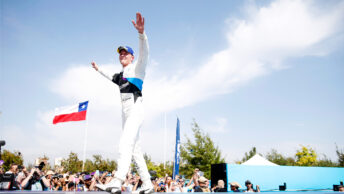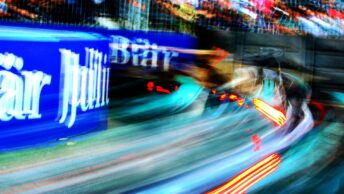The Santiago E-Prix noticeboard received a relatively modest papering compared to the Diriyah E-Prix, getting to a mere 21 stewards’ decisions compared to the first two races which reaching a lavishly-pinned combined total of 45. Still, it wouldn’t be Formula E without a few post-race results reshuffles and the threat of offensive underwear so here’s a full run-down of everything that happened and why.
Settle in, it’s not short.

REGULATORY BREACHES
We all know motorsport has a lot of rules. Most of us are – or think we are – pretty familiar with a lot of even the more abstract ones in Formula One but in a sport as young and rapidly-developing as Formula E and hidden in documents as inpenetrable as FIA-issued tomes often are, it’s easy to think Formula E’s look a bit inexplicable and arbitrary as a result.
The truth is, we’re just not as used to them. And the drivers that tend to comment on them have, of course, usually fallen foul of them so of course they’ll say that it’s a completely ridiculous restriction that’s killing racing or technical innovation or even puppies, if it’ll get them back a result.
A lot of these offences tend to come under Article 27.9 of the Sporting Regulations, which helpfully covers “It is mandatory to follow the instruction manual from the FIA-designated supplier at all times.”
That means, in short, not doing anything that Spark (the chassis supplier), Michelin (tyre supplier) or McLaren (the Gen2 battery supplier) say you shouldn’t – and fully applying the procedures that they say you should. Most of these types of penalties are financial and see teams or competitors issued with fines, rather than sporting penalties.
So who pushed the regulatory envelope a bit far this weekend? Stoffel Vandoorne’s side of the Mercedes garage kicked us off pre-Friday shakedown with over-cooled coolant, amassing a €1,500 fine towards the free bar at the FIA gala this year. Might seem a bit harsh to say your coolant has to have a certain minimum temperature but well, chemistry is complicated and sometimes colder things heat up faster or more unstably.

Mercedes then made the same coolant temperature error on De Vries’ car in the race, gaining him a five-second time penalty that saw him finish third on track but be penalised from the podium.
Mitch Evans followed it up with another 27.9 breach in FP1, with a ‘failure to respect the power availability’ according to McLaren’s software installation guide. Which is to say, somehow what energy they reckoned was in the battery wasn’t what it was saying it had. There’s a whole bunch of reasons teams might push that envelope on a race with high regen demands, the biggest one being starting with a little bit less energy might let you regenerate more, earlier when the battery is cooler. Or Jaguar might have made a mistake, of course. Ma Qinghua’s hastily rebuilt NIO 333 car faced the same penalty later, pre-race.
Oliver Rowland’s crash in qualifying saw him become decision #7 – he was permitted to leave Parc Ferme (the impounded state cars are put into for stewards’ inspection after a session) early, in order for Nissan e.Dams to work on repairing his car for the race but also disqualified from the whole session and set to start from the back of the grid. Which was where he was anyway, so no real impact.
The same thing happened to Ma Qinghua following his FP2 crash and with the same result – since he hadn’t been able to participate in qualifying, he would have started from the back anyway.
Then NIO 333 and Porsche were both fined for having team members work on the cars without long-sleeved clothing, while they were charging. It might seem unfair to mechanics to force them into long sleeves at a hot race but it’s a safety measure to attempt to avoid electrical burns or electrocution – and only merited €2500 apiece.
TECHNICAL DETAILS
Jerome D’Ambrosio received a post-race drive-through penalty for the output from the battery in his car not corresponding to the throttle map submitted to homologation. So in other words, more or less power was being used when he pushed the pedal than Mahindra had declared. Fairly easily explained by the heat as it’s not a very commonly seen one but Sebastien Buemi was also penalised for the same thing, again just after provisional results had been posted. Both received a converted drive-through of 30 seconds penalty.
The final penalty handed out was to Andre Lotterer, who was clearly popular with the stewards this weekend, for over-use of power (230.5kW rather than 200kW when not in Attack Mode) – a similar thing happened to Oliver Turvey in Riyadh and it seems sort of clear-cut but (at least, Turvey’s explanation for it was this) it’s a symptom of a powertrain under stress, a bit like the time Daniel Ricciardo got an energy spike from his MGU-K going over a kerb in F1.

SPORTING MISBEHAVIOUR
Oh, you all know what this is. All sports, from the most basic playground game of tag to the highest-end of motorsport, have rules in order to set out the way you win or lose or play the game. Otherwise it would just be a sort of free-for-all track day.
Sporting breaches are things where you just did the wrong thing. In this weekend’s case, Antonio Felix da Costa was stewards’ decision #2 for speeding in the pit lane on Friday and incurred a €1000 fine for it.
Decision #4 saw Jerome D’Ambrosio slapped on the wrist for speeding under a Full Course Yellow but nothing more than that in the penalty box.
A sea of drivers were issued drive-through penalties for causing collisions in the race, starting with Oliver Rowland whose front wing was gone from virtually the start, after contact at the back of the grid. Daniel Abt was next, for early contact that span Sam Bird. Nico Mueller joined the 10-second penalty party post-race for the same reason, shortly followed by Andre Lotterer.
Lotterer then also received a reprimand for an unsafe rejoining of the track following a collision but no further time penalty.
Ma Qinghua failed to use Attack Mode during the race (there are a minimum number of arming and activations you must use) and received a ten-second stop and go penalty for it.
SHENANIGANS™️

Ah, the interesting section. Dragon kicked this off by forgetting to remove a bracket supporting cooling blowers from a car before sending it out of the pits, as decision #6 – a hefty €5000 for the FIA.
Famously, Formula E has had a few (hefty) fines issued to drivers – in Punta del Este and New York in Season 4 – for “underwear offences.” Not what it sounds like, this is if they’re caught not wearing their FIA-mandated thermal, fire-resistant under layers. Drivers have to wear clothing that’s resistant to heat and fire and it’s not massively comfortable if you’ve been sweating all over it during a warm session.
You quite often see a few coat hangers around the paddock, drying sweaty thermals in the air. But you can see the drivers’ point about not wanting to put really grimy ones back on -unfortunately, even if the risk of a fuel fire is nonexistent in Formula E, the risk of a battery fire is a lot more than zero so they do have to.
The good news is that “some drivers” inspected after qualifying were all found to be fully underwear compliant…







The number (and timing) of penalties is crazy – for the infringements that can be automatically measured (temperatures, power, have you actually followed the most basic element of the rules and use your attack mode twice) then they should be coming during the race, or immediately after the flag drops so you have a proper podium. The technology to do this is not complicated.
Was there not notification post-race that an in-race time penalty was being reassessed and punished as a drive-through? If so, this just seems unfair and amateur, unless there was a good reason behind it?
How are the throttle maps and overuse of power occurring? There’s allusions to ‘pushing the envelope’ which sounds like a very English way of saying cheating (without the risk offending friends in the team!). Is this not all linked to a software program with some binary selection of power output? I can’t see (but happy to be informed) how you can get your maximum power output ‘wrong’ accidentally.
Would also be good to understand what reason Ma Qinghua had for not using Attack mode – was it tactical, was it a misunderstanding of the rules, or did they think they’d activated it twice?